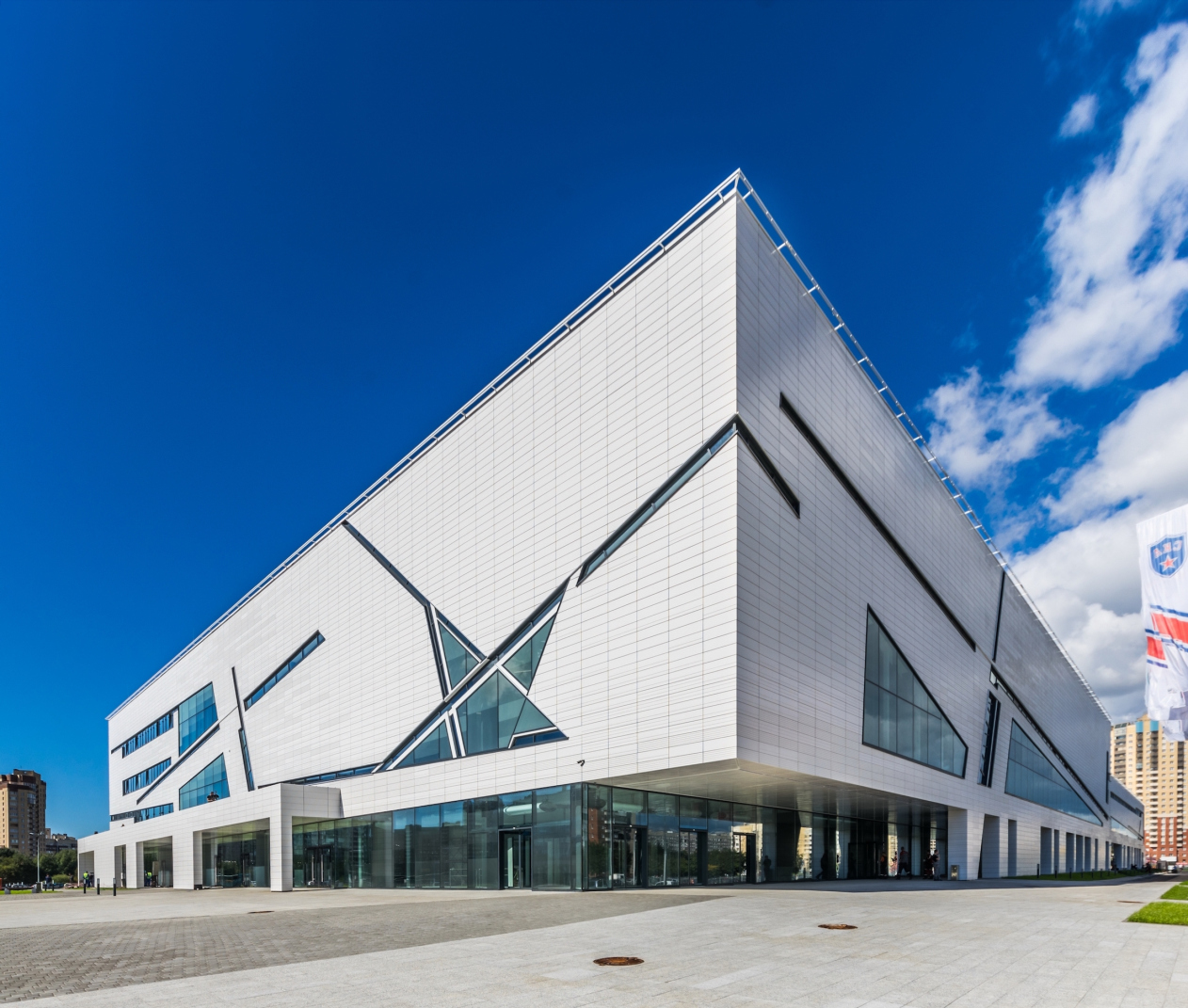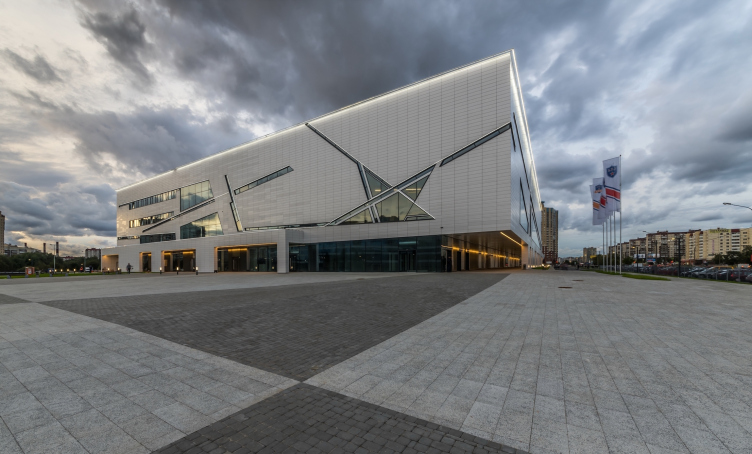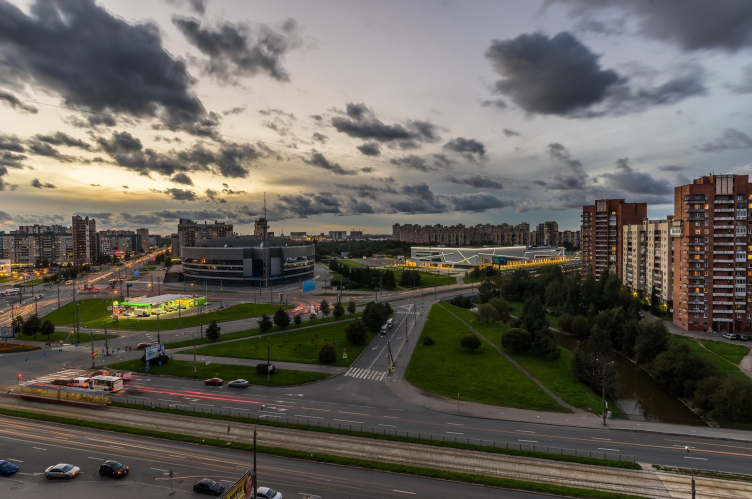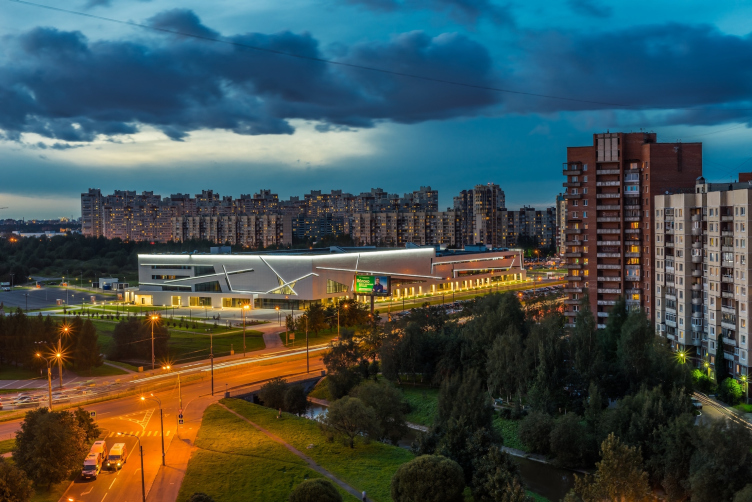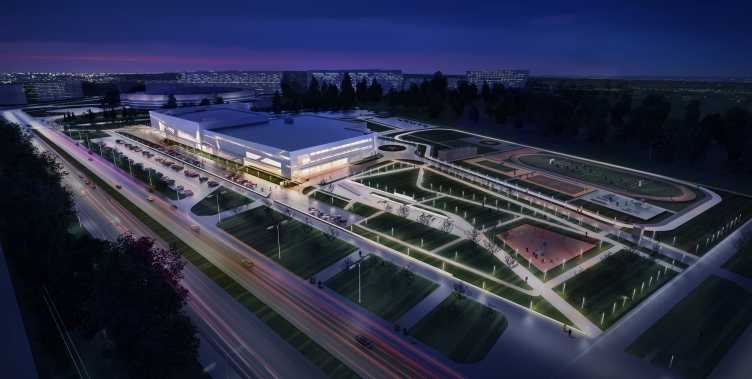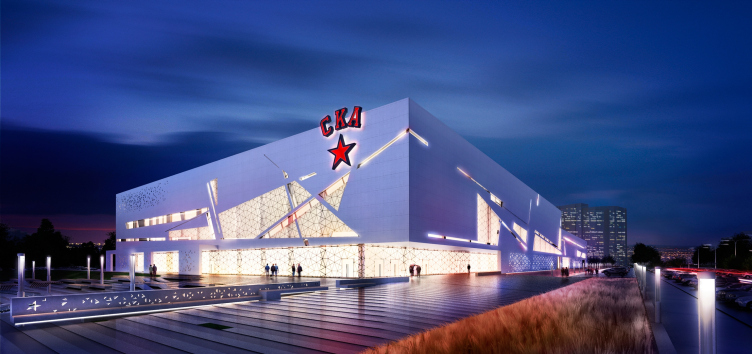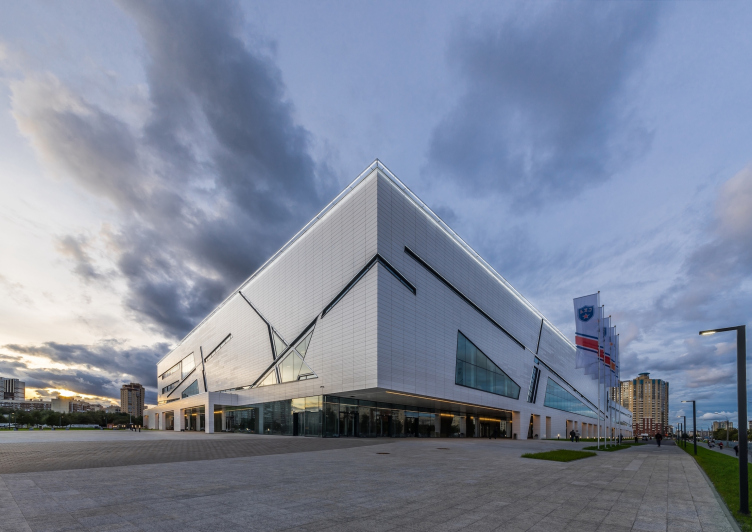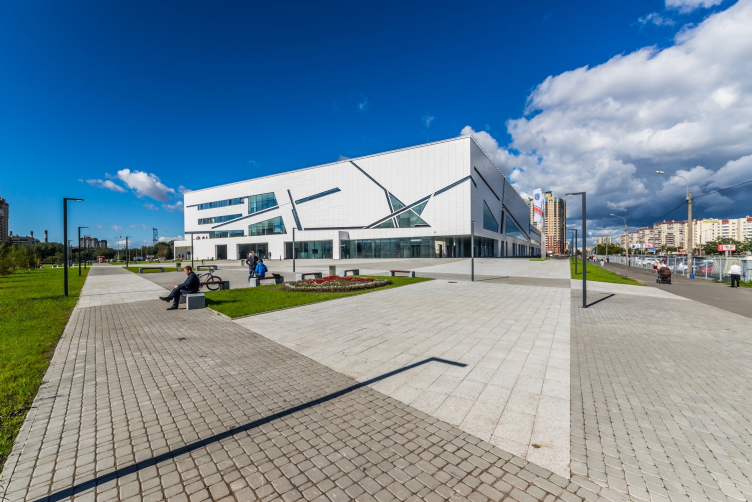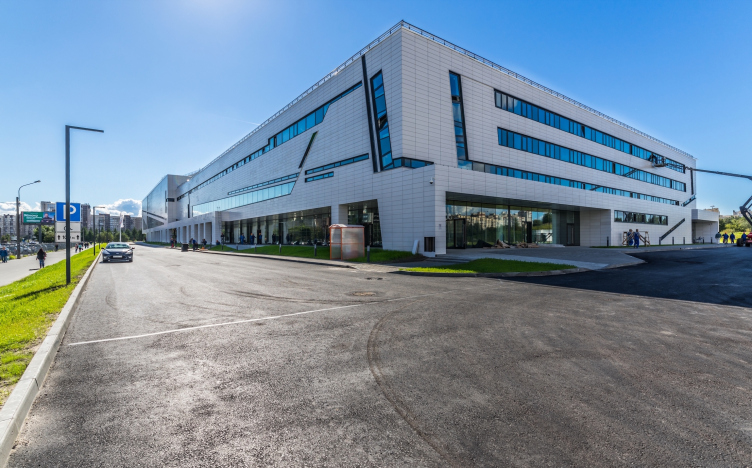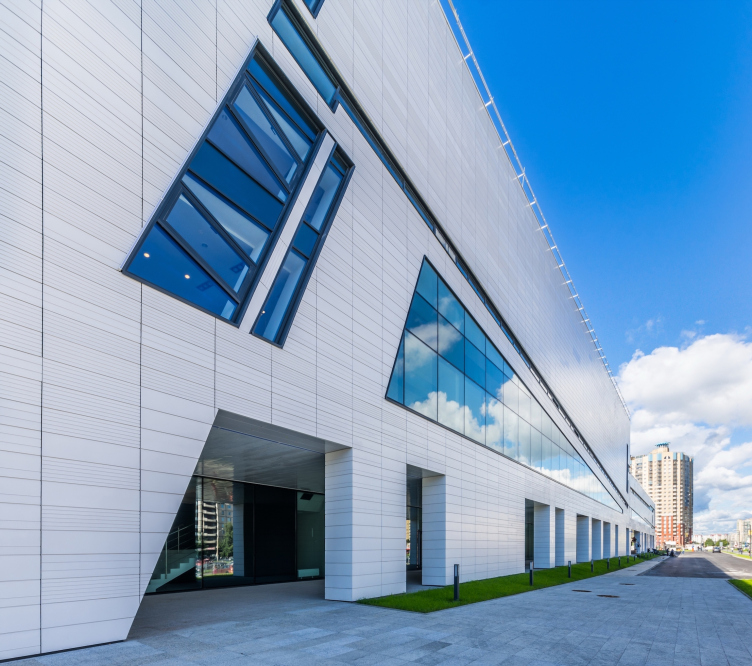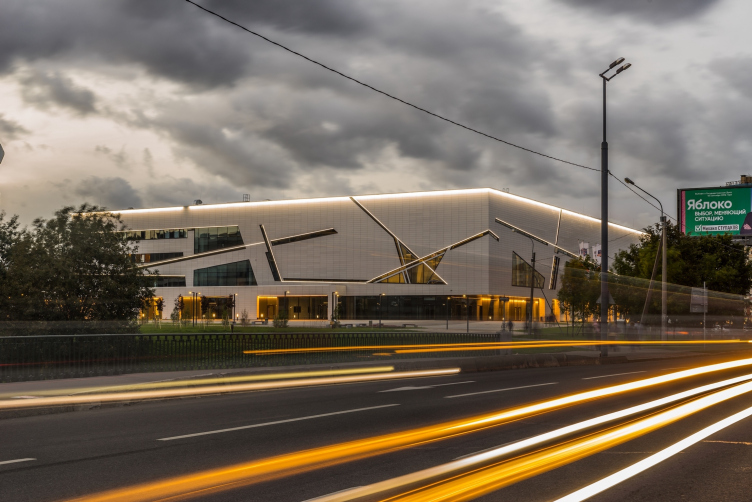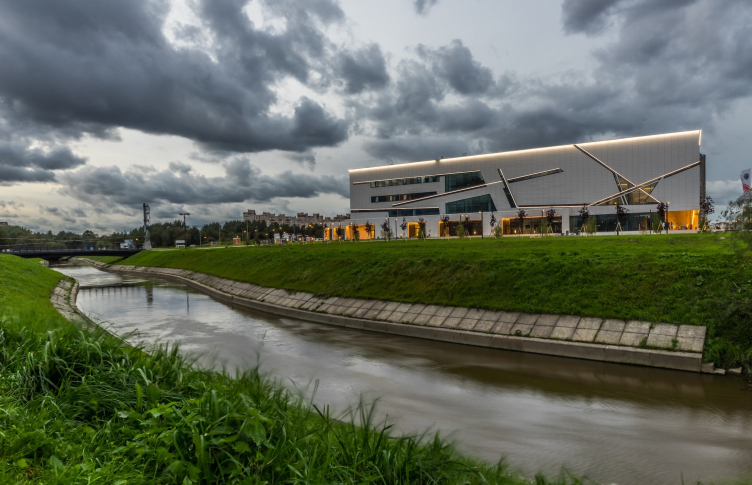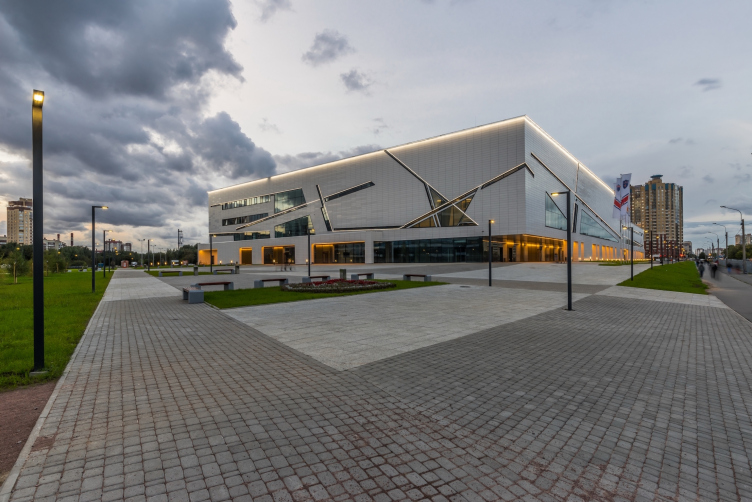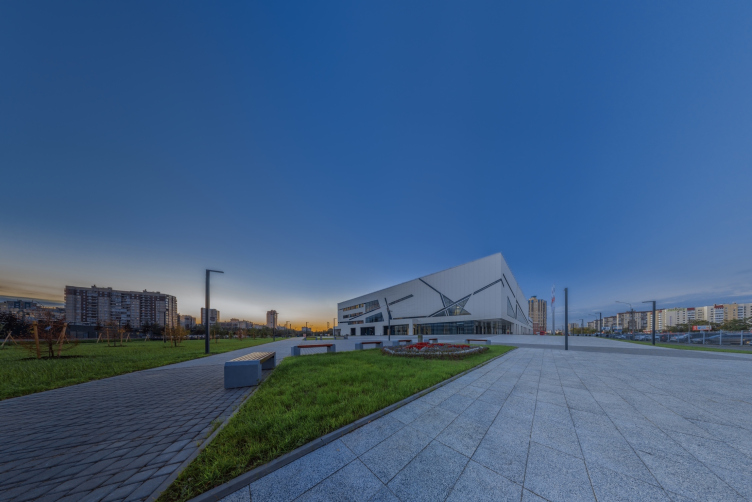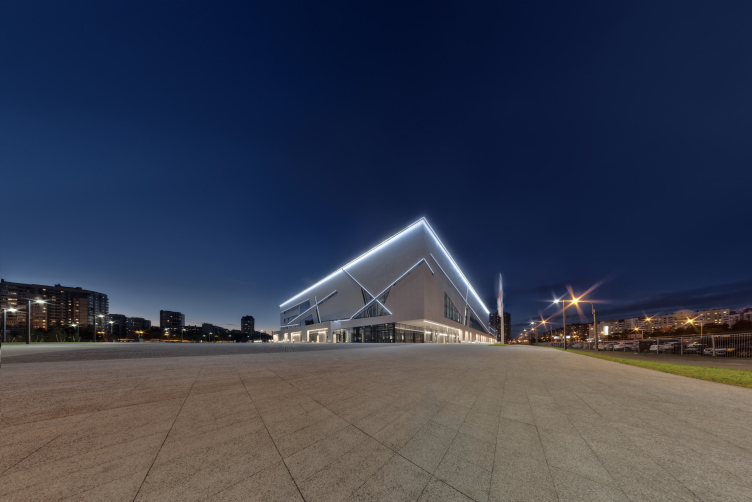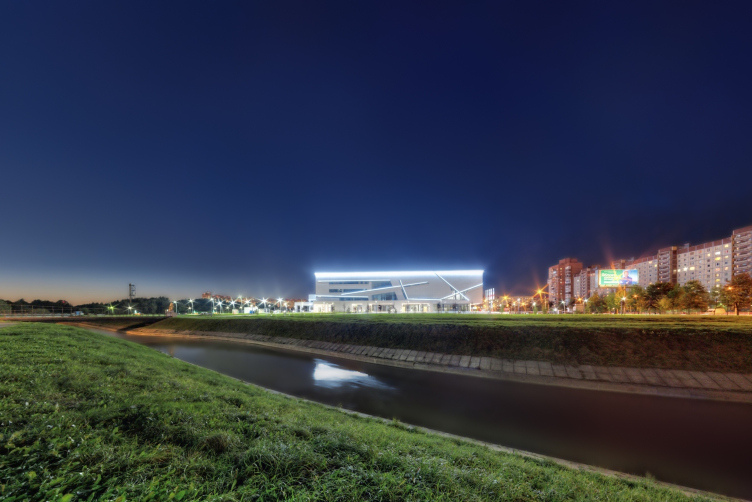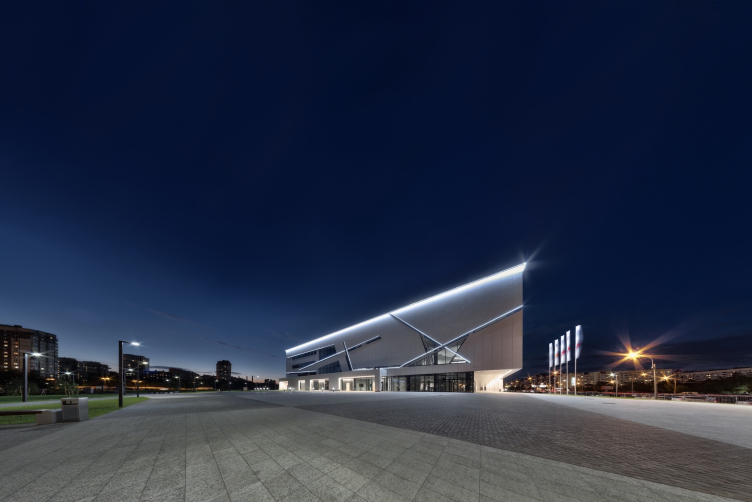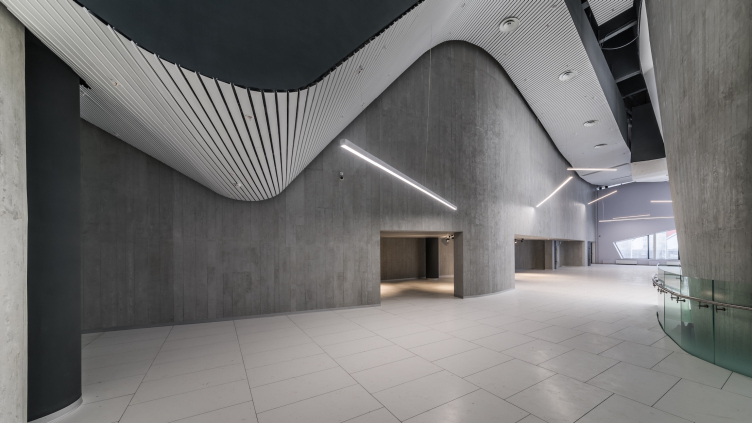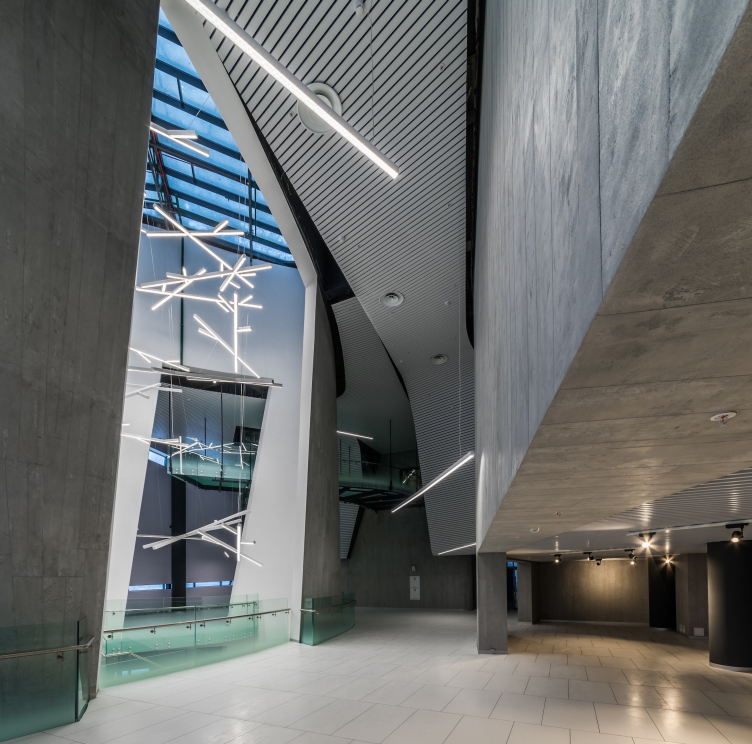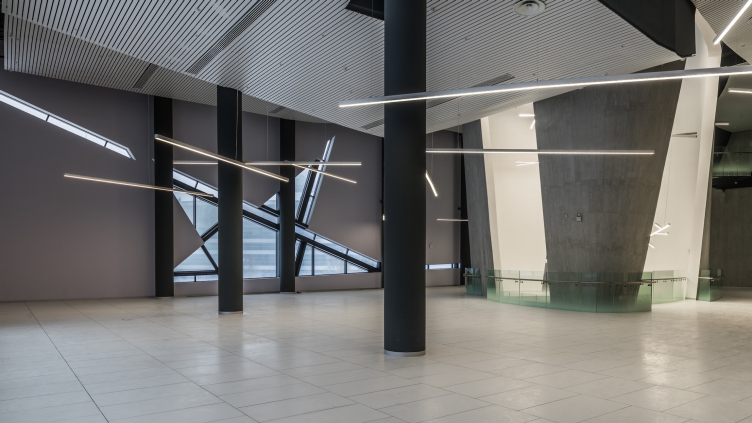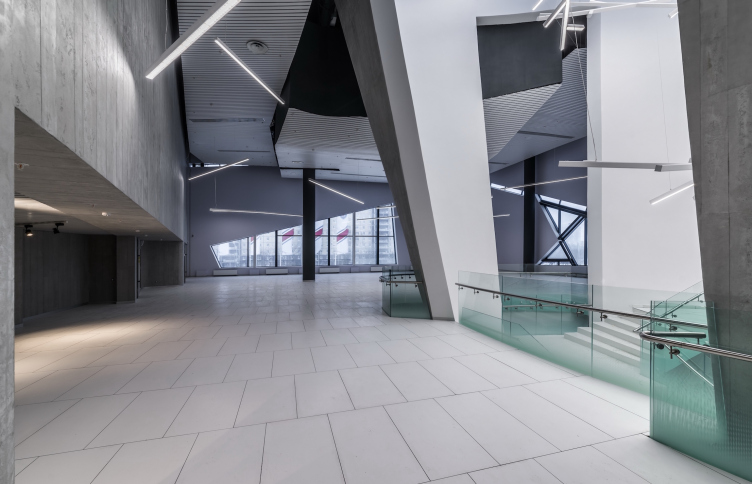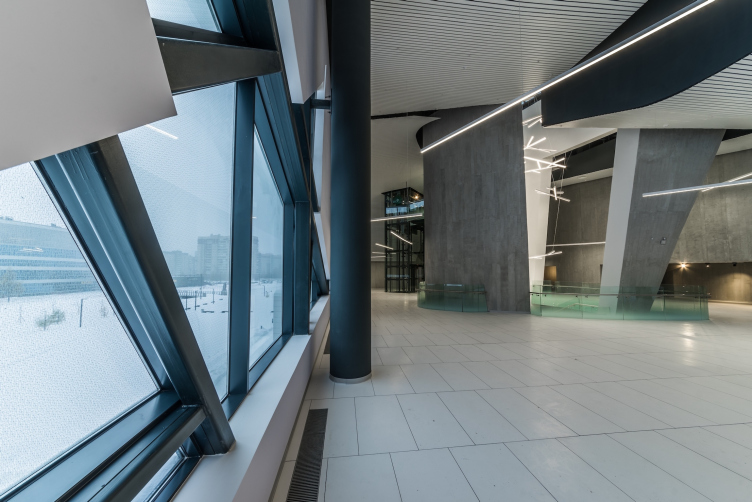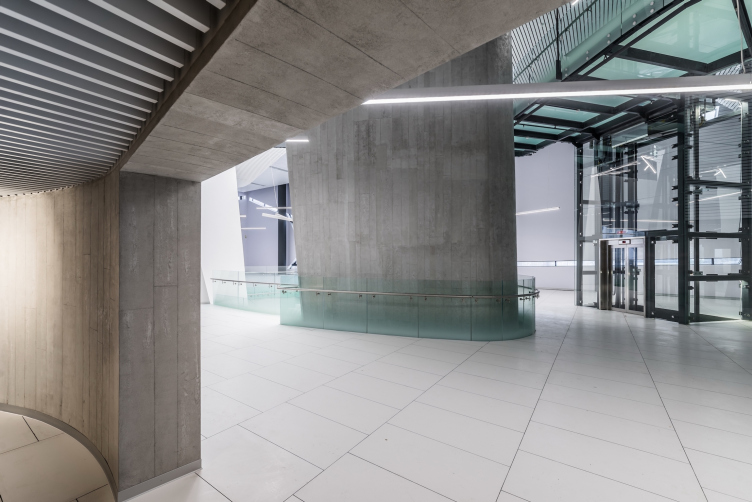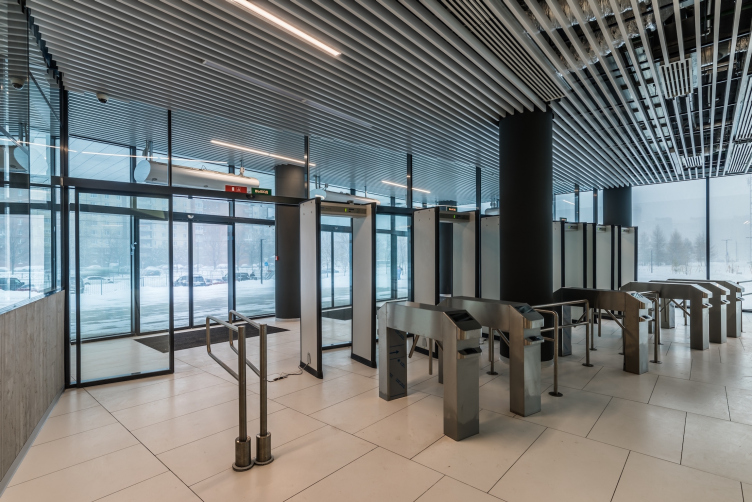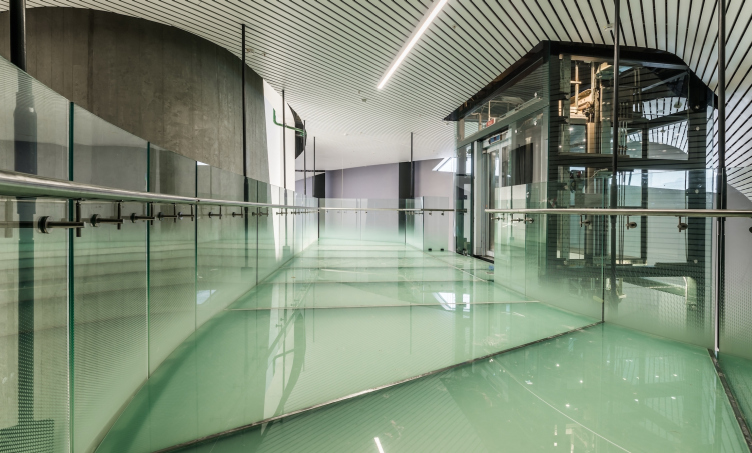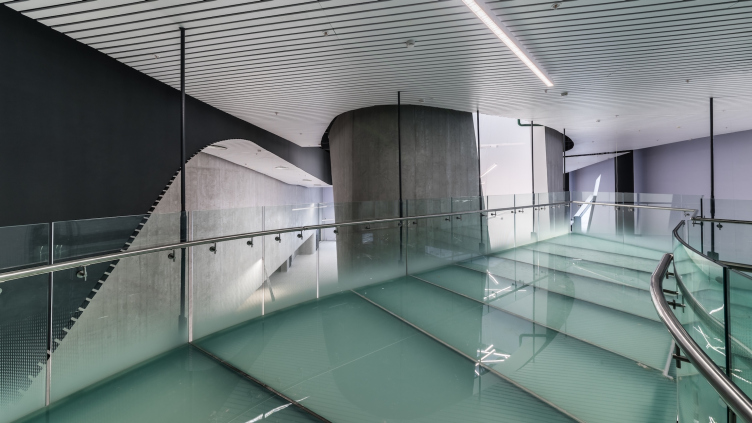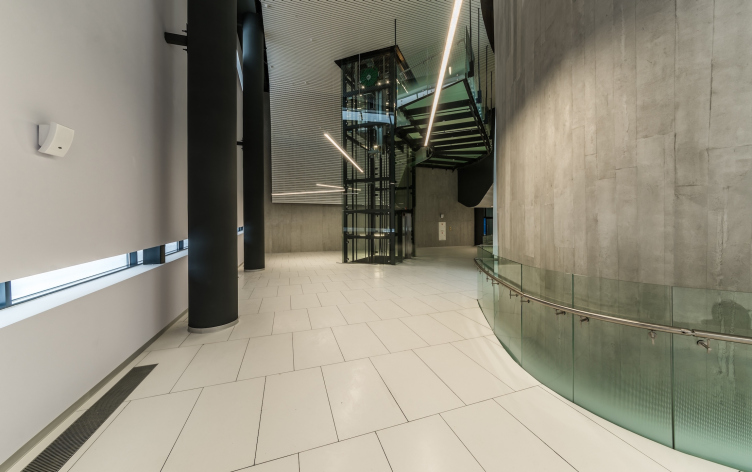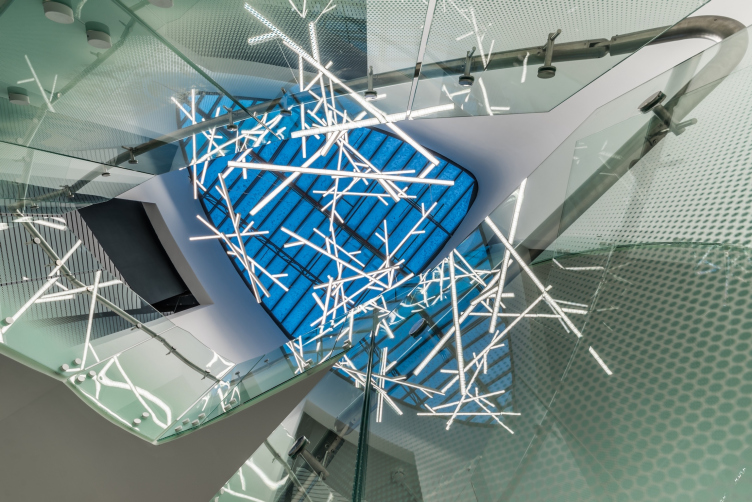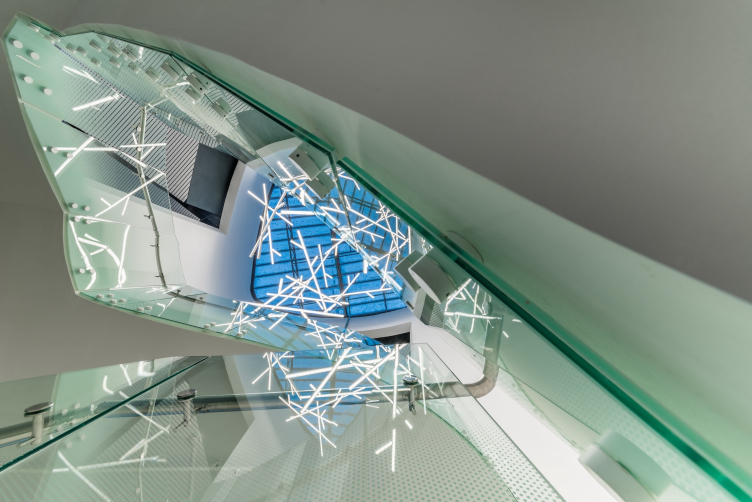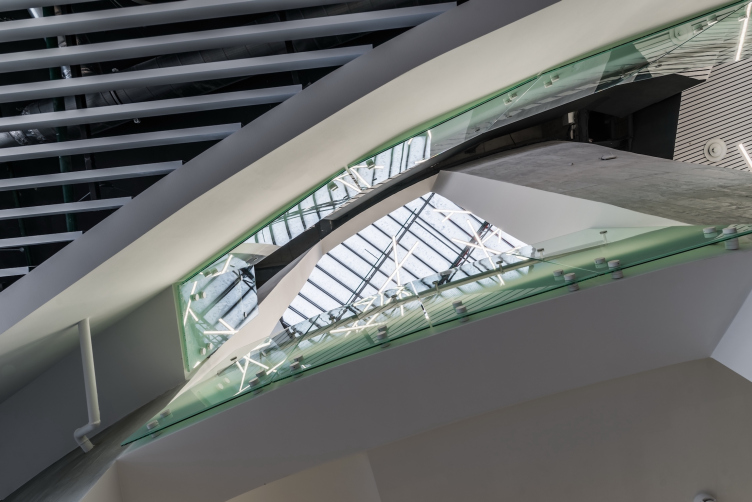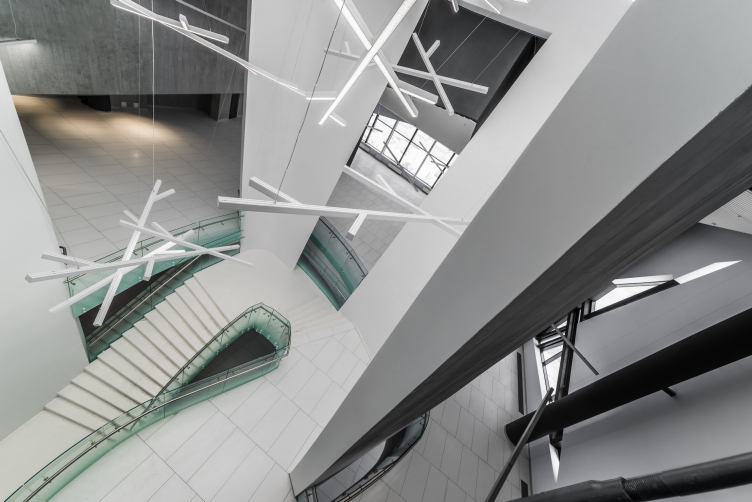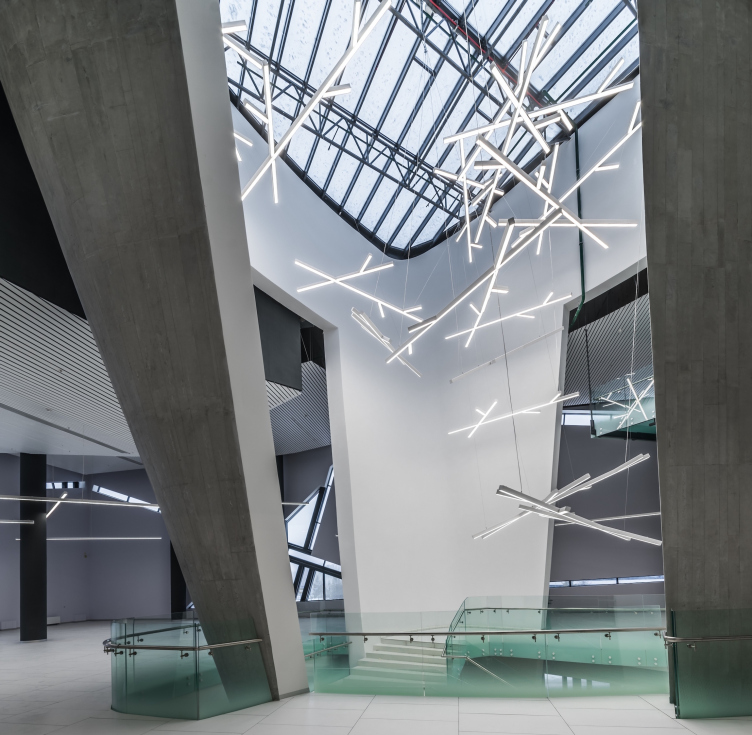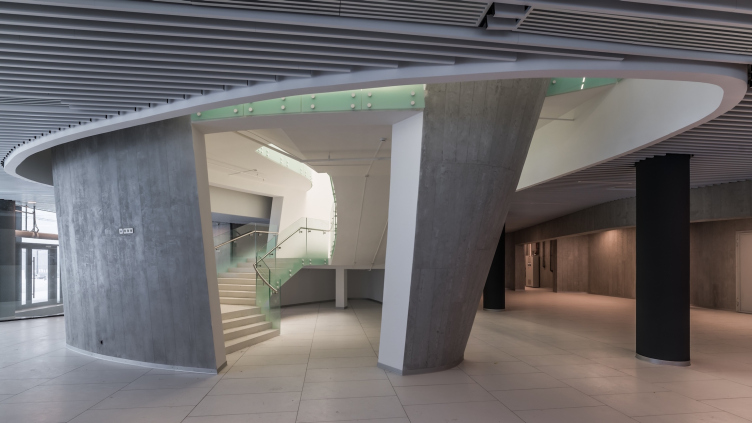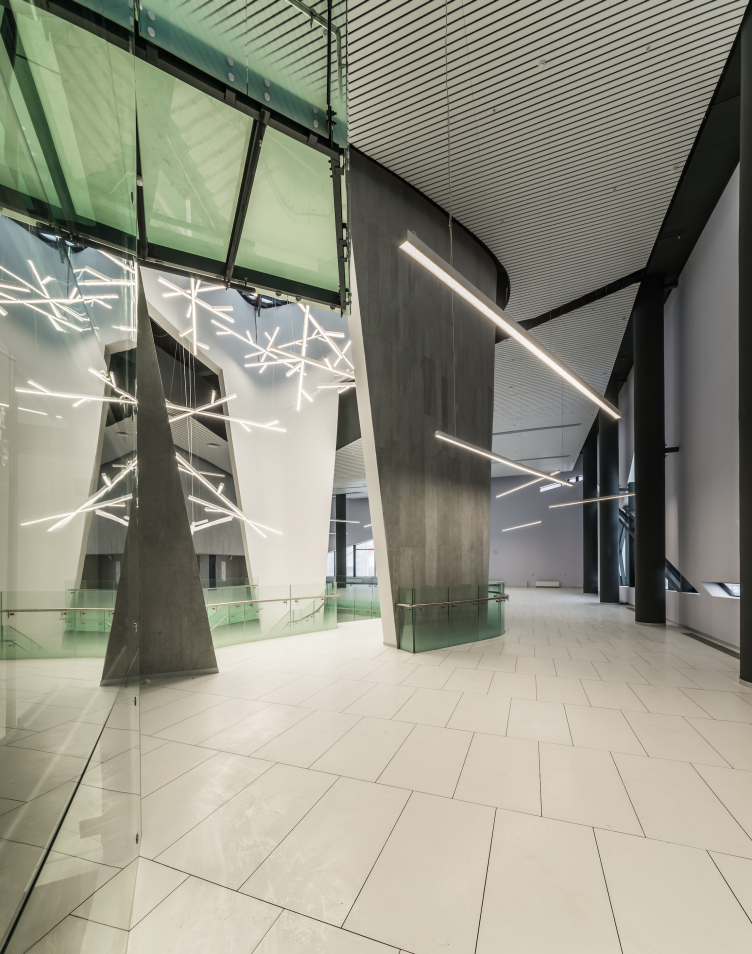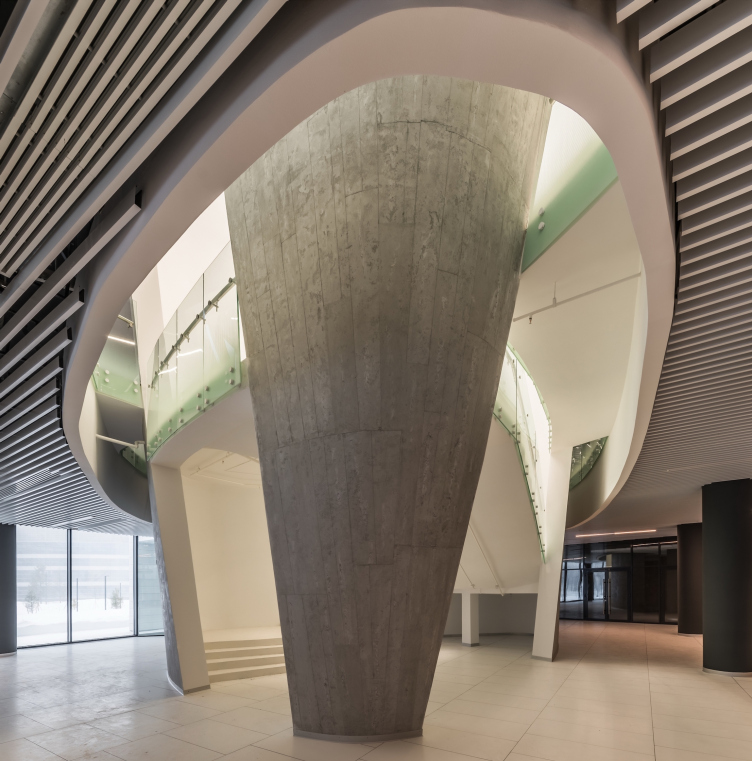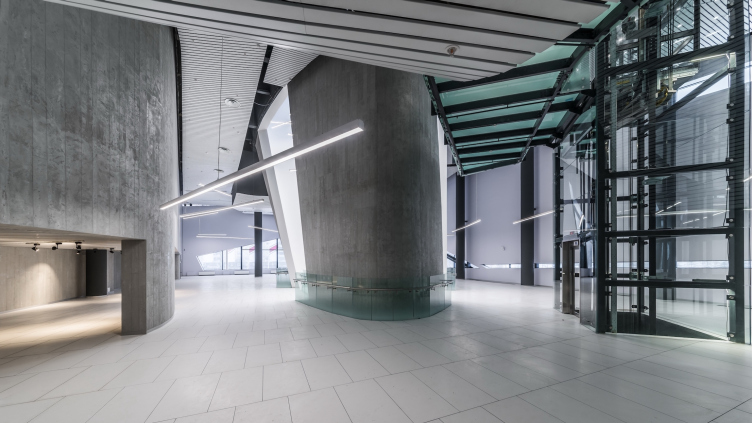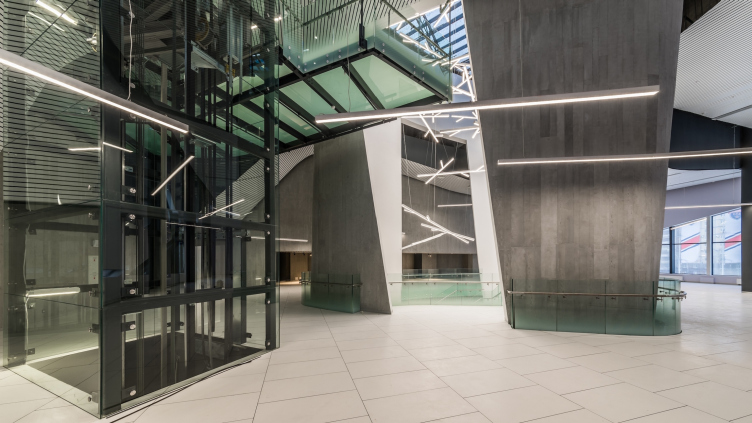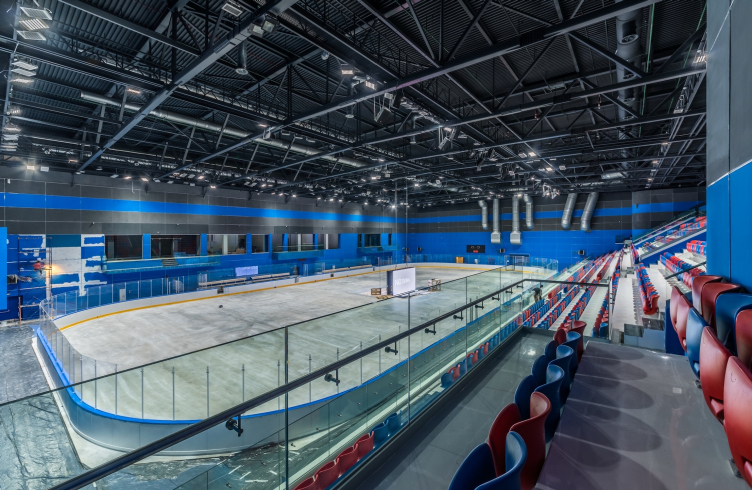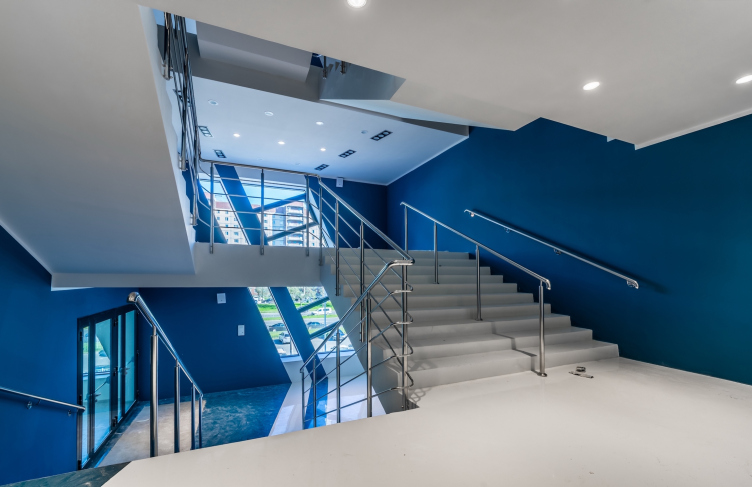The new sports complex belonging to the SKA hockey club is located in an east suburb of Saint Petersburg not far away from the Ice Palace. The two sports facilities are separated by the small Okkervil River over which the pedestrian “Ice Bridge” has been thrown. The new building is meant to accommodate the training sessions of the SKA hockey team and local tournaments. The sports complex is situated in the east part of a small city park that back in the 1970’s used to be the dumping ground for the building rubble that formed a formidable hill. Before the construction began, the territory was cleared, and after the construction ended, it was organized. Next to the complex, there is an open-air stadium, jogging and bike tracks, and a children’s playground.
Sports complex of SKA hockey club. Implementation, 2016 © A.Len Architectural Bureau
Copyright: © A-Len
Sports complex of SKA hockey club. Implementation, 2016 © A.Len Architectural Bureau
Sports complex of SKA hockey club. Implementation, 2016 © A.Len Architectural Bureau
Project of the sport complex SKA. Project, 2012 © "A.Len" Architectural Bureau
Headed by Sergey Oreshkin, the team of A.Len won the tender for the project of SKA sports complex in 2012 submitting a concept in the form of a bent horizontal slab meant to embody the image of movement and speed. In 2014, however, under the pressure of the economic crisis, the project was to be drastically changed in order to reduce the construction costs. The sophisticated shape had to give way to a simple parallelepiped about 200 meters long and 19 meters high that the architects were nevertheless able to turn into a landmark on Saint-Petersburg’s sports map.
Project of the sport complex SKA. Project, 2012 © "A.Len" Architectural Bureau
The laconic volume of the complex looks like a huge chunk of ice thanks to its façade covered with large slabs of natural white ceramics of four types – glazed, opaque, and corrugated, this difference of textures creating an extra play of glints and reflexes on the wall surfaces that echoes the diagonal slender lines of the façade stained glass windows. The façade composition that brings to mind the creative work by Daniel Libeskind, adds to the dynamic image of the building. The façade’s slits and chamfers that look particularly impressive in the evenings come together in one spot – the five-point-star-shaped window which has in fact been the logo of SKA club since the 1940’s.
Sports complex of SKA hockey club. Implementation, 2016 © A.Len Architectural Bureau
Sports complex of SKA hockey club. Implementation, 2016 © A.Len Architectural Bureau
Sports complex of SKA hockey club. Implementation, 2016 © A.Len Architectural Bureau
Copyright: © A-Len
Sports complex of SKA hockey club. Implementation, 2016 © A.Len Architectural Bureau
Sports complex of SKA hockey club. Implementation, 2016 © A.Len Architectural Bureau
Sports complex of SKA hockey club. Implementation, 2016 © A.Len Architectural Bureau
Sports complex of SKA hockey club. Implementation, 2016 © A.Len Architectural Bureau
Sports complex of SKA hockey club. Implementation, 2016 © A.Len Architectural Bureau
Sports complex of SKA hockey club. Implementation, 2016 © A.Len Architectural Bureau
Sports complex of SKA hockey club. Implementation, 2016 © A.Len Architectural Bureau
Sports complex of SKA hockey club. Implementation, 2016 © A.Len Architectural Bureau
Sports complex of SKA hockey club. Implementation, 2016 © A.Len Architectural Bureau
Copyright: © A-Len
The façade theme continues inside the complex as well, transforming into more sophisticated 3D shapes and structures. Getting inside, we feel as if we find ourselves inside a chunk of ice, whose image is marked on its façades. The interior design is pristine and laconic but still dramatic and full of inner symbolism. The wall finish – a high-quality concrete simulation – is accentuated by the gray bands of enclosure ceilings and a white floor covered in ceramic granite tiles. The black color of the round columns fits in with the tone of the basket-work of the windows, which produces an effect as if the white building were strung on a black framework that supports at the same time the gray chunks of ice. This cool, austere, and powerful image is very resonant with this masculine kind of sport.
Interior of the entrance lobby and the museum of the sports complex of SKA hockey club. Implementation, 2016 © A.Len Architectural Bureau
Interior of the entrance lobby and the museum of the sports complex of SKA hockey club. Implementation, 2016 © A.Len Architectural Bureau
Interior of the entrance lobby and the museum of the sports complex of SKA hockey club. Implementation, 2016 © A.Len Architectural Bureau
Interior of the entrance lobby and the museum of the sports complex of SKA hockey club. Implementation, 2016 © A.Len Architectural Bureau
Interior of the entrance lobby and the museum of the sports complex of SKA hockey club. Implementation, 2016 © A.Len Architectural Bureau
Interior of the entrance lobby and the museum of the sports complex of SKA hockey club. Implementation, 2016 © A.Len Architectural Bureau
Interior of the entrance lobby and the museum of the sports complex of SKA hockey club. Implementation, 2016 © A.Len Architectural Bureau
Interior of the entrance lobby and the museum of the sports complex of SKA hockey club. Implementation, 2016 © A.Len Architectural Bureau
Interior of the entrance lobby and the museum of the sports complex of SKA hockey club. Implementation, 2016 © A.Len Architectural Bureau
Interior of the entrance lobby and the museum of the sports complex of SKA hockey club. Implementation, 2016 © A.Len Architectural Bureau
The most impressive part of the entrance lobby is a small atrium next to the roof lantern. The concrete “shield” looking like hockey gear, belts the turn of the white steps brightly backlit from the inside by a complex system of lamps whose light is reflected and multiplied in the glass panels of the railings. A multitude of other lamps suspended on all-but-invisible thin cords and diagonal light slits in the walls, just as thin.
The atrium looks as if it has been literally molded into shape. In order to mold its slanted walls, a special kind of ribbed framework casing was developed – a unique technology for the current Russian architecture, especially considering the reduced financial circumstances.
Interior of the entrance lobby and the museum of the sports complex of SKA hockey club. Implementation, 2016 © A.Len Architectural Bureau
Copyright: © A-Len
Interior of the entrance lobby and the museum of the sports complex of SKA hockey club. Implementation, 2016 © A.Len Architectural Bureau
Interior of the entrance lobby and the museum of the sports complex of SKA hockey club. Implementation, 2016 © A.Len Architectural Bureau
Interior of the entrance lobby and the museum of the sports complex of SKA hockey club. Implementation, 2016 © A.Len Architectural Bureau
Interior of the entrance lobby and the museum of the sports complex of SKA hockey club. Implementation, 2016 © A.Len Architectural Bureau
Interior of the entrance lobby and the museum of the sports complex of SKA hockey club. Implementation, 2016 © A.Len Architectural Bureau
Interior of the entrance lobby and the museum of the sports complex of SKA hockey club. Implementation, 2016 © A.Len Architectural Bureau
Interior of the entrance lobby and the museum of the sports complex of SKA hockey club. Implementation, 2016 © A.Len Architectural Bureau
Interior of the entrance lobby and the museum of the sports complex of SKA hockey club. Implementation, 2016 © A.Len Architectural Bureau
Interior of the entrance lobby and the museum of the sports complex of SKA hockey club. Implementation, 2016 © A.Len Architectural Bureau
As for the hockey field itself, by contrast with the entrance lobby, it looks like a very simple “technology” thing: the floor structure, the gray-and-blue walls, and the trademark-red spectator seats. In addition to the main hockey box with seats for a 1000 people, skyboxes, and a sound system, the complex also has a second training field. The main engineering block is squeezed between the two ice boxes which allowed the architects to cut down the overall length of the utility lines. In addition, the building has in it a few gyms, a swimming pool, a medical center, a hotel for guest athletes, and a cafe. This place will host championships, sport practices for general public, concerts, and children’s New Year’s parties; coming soon are a sports school and a public skating rink.
Interior of the entrance lobby and the museum of the sports complex of SKA hockey club. Implementation, 2016 © A.Len Architectural Bureau
Interior of the entrance lobby and the museum of the sports complex of SKA hockey club. Implementation, 2016 © A.Len Architectural Bureau
This new hockey complex clearly shows the original energetic and artistic message of the contest-winning project, modest and appropriate on the outside and striking-looking, very much like a theater foyer on the inside. So it comes as no surprise that, while still in the construction stage, it was able to get three “silver” awards or Saint-Petersburg: two “Golden Capitols” and one “Arkhitekton”.
Project of the sport complex SKA. Facade © "A.Len" Architectural Bureau
Project of the sport complex SKA. Facade © "A.Len" Architectural Bureau
Project of the sport complex SKA. Section view. Project, 2012 © "A.Len" Architectural Bureau

